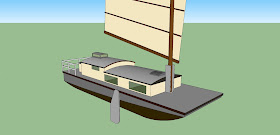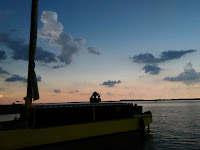Lean on me
When you're not strong
And I'll be your friend
I'll help you carry on
For it won't be long
Till I'm gonna need
somebody to lean on.
-- Lean on Me by Bill Withers
Leaning on Love
One time, we got into some bad water. Under the belt, this time, rather than the keel.
We were visiting Anke's family in Germany in our early years together. Family had work or school, weekdays, so we took to bikes and toured far and wide. October in the Old Country. Camping and eating cold (fires are frowned upon).
In one beautiful stretch near the Swiss border, we'd gone through our water. We were in a
Naturschutzgebiet; a nature preserve, and for once, no civic water supply. But we were following a small, pristine looking river upstream, that ran through woodlands. Our map showed it originated in hills within the preserve, exiting its boundries at a point well downstream.
Anke was parched, and decided to drink.
I hemmed and hawed a bit... Germany is settled pretty much cheek on jowl. This preserve, while locally a big deal, looked to my Alaskan eyes like a stonethrow in each direction.
But what's good for my goose... I took a few sips, and it was wonderful.
Next morning, we continued upstream, thinking we might take a look to see what produced so much water from such a small watershed (can you see it coming?). We rounded the shoulder of a hill. The river should have, too, heading up a small valley. Instead it went the other way, toward the boundary of the preserve, and we soon found ourselves pedaling among cows and sheep. You know...
upstream cows and sheep.
D'oh!
We monitored our bowels all day, while slowly cycling higher in elevation. No problems... must have dodged that bullet! At the end of the day, we had a long coast down to the Rhein, with the Alps towering above us in full, evening roses and blues... alpenglow in all its glory.
We stopped in a town and asked about a camping spot. A very nice woman offered for us to stay at her campground, which had just closed to paying customers for the off-season. Still had power and running water!
Well... it caught Anke that night. Both ends with me trying to position a blanket between.
Next morning, I was still feeling okay. Since there was power, I had an idea... how 'bout I cycle in and buy an
immersion heater (a little, electric coil you dip in a cup or pot to heat it) and some soup packets?
Right. Good plan. But my German was still not much better than a monkey's, and Anke's English, while plenty for conversation, didn't cover an immersion heater. Took us a couple hours of charades and 20 questions and little drawings before she finally exclaimed,
"Ach ja! Ein Tauchsieder!"
Right.
Tauchsieder. Dip-Boiler. Not an easy word to pronounce. Took me another half hour to learn it.
So I'm feeling a little...
fluid by now. I wobble into town, and, depending heavily on the kindness of strangers, locate a shop with a window
full - I kid you not - of dip-boilers in all sizes. Turns out they're fairly common in Europe.
Well, I make it back before installing myself on a throne (bathrooms luckily still open). We sip soup and mint tea for three days, which runs through us like a river, as it were.
There was more... The part about the scary man who initially led Anke to the campsite owner (me 'guarding' the bikes as Anke disappears into a dark alley with this rough looking guy as night comes on). The owner who let us stay on as long as we liked, drove down to offer blankets and home made apple
schnapps (both declined, but with great appreciation... bless you, Frau Wolfgang, wherever you are!).
When it was more or less over, we dared our first venture through town on foot. Arm in arm, leaning each on the other,we scouted each next facility before leaving the last.
We remember this as one romantic interlude among the many.
It's something, facing a storm in the gathering dusk with safe harbor still ahead, to know one is not alone. To know that our strength and courage are aligned. To know that our fear and weakness will be heard and backed up. To reach for a hand in the darkness...
To lean on love.
*****
The little town where this all went down is called Stuehlingen ('shtool-eeng-gen [hard g like get]). It became a verb in our couple-speak; We
steuhlingen our way through a difficult period with lots of love and alternating, mutual support.
Since writing this, we took in Casey, our new partner. As you might imagine, this required some deep adjustments for Anke and me. We stuelingened our way through them and kept our feet, sailing on closer than ever.
Happy Valentine's Day to you, too!














